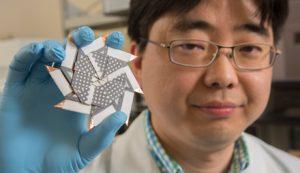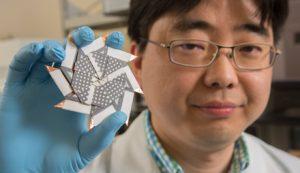Origami Star-Inspired Biobattery Runs on Wastewater
June 17, 2016

We told you awhile back about an organic, paper-based and origami-inspired battery that could produce energy using just a few drops of water -- origami, of course, being the Japanese art of paper folding. Well the designer of that battery -- Binghamton University Professor Seokheun "Sean" Choi -- is at it again with a new disposable bio-battery inspired by a folding origami ninja star that could provide energy for biosensors and other portable devices, particularly in underdeveloped regions of the world.
Choi and two of his students developed the latest design, a microbial fuel cell that, like its predecessor, runs on bacteria that's available in a few drops of wastewater. The new design folds into a star with one inlet at its center. The electrical contacts are at the points of each side, according to researchers.

Placing a few drops of dirty water into the inlet allows the device to be opened into a Frisbee-like ring, which in turn enables each of the eight fuel cells to work. Each module of the device includes five stacked layers that on their own are functional, each with its own anode, proton exchange membrane, and air-cathode, Choi told Design News.
"We had to stack more batteries in series to increase the operating voltage in a small footprint," he told us. "Also, we wanted to add the smaller amount of and fewer times of bacteria samples to the device. During this introduction, the batteries should be disconnected until the bacterial cells are fully acclimated and attached to the electrode surface. This ninja star one satisfied all the requirements."
The biggest improvement in the origami-star battery over its predecessor is its ability to provide enough power for a device rather than merely serve as an experiment to prove a design idea. "Last time, it was a proof of concept," Choi said. "The power density was in the nanowatt range. This time, we increased it to the microwatt range. We can light an LED for about 20 minutes or power other types of biosensors."
Also different to the earlier origami-inspired design is the way the batteries are placed in the device. While the first paper-based design was shaped like a matchbook and stacked four modules together, the ninja-star version -- which measures about 2.5 inches wide -- includes eight small batteries connected in series.
The new battery also uses less water to function. "When closed, we can drop just one drop of bacterial sample in the middle of a device while the batteries are disconnected," Choi said. "Then, we open the device for the series connection. Also, when we open the device, cathodic parts of the batteries are exposed to the air for their cathodic reaction with the oxygen in the air. Our previous origami device required more than one drop of the sample. Also, the batteries were already connected during this introduction process."
READ MORE ARTICLES ON BATTERY RESEARCH:
One drawback to the new design, however, is that it is more expensive to produce than the matchbook-sized battery -- at 70 cents to the previous 5 cents per device, according to Choi. This is in part because it uses both filter paper and carbon cloth for the anode as well as copper tape. However, Choi and the team plan to develop a fully paper-based device that can combine the origami-star design's power capability with a lower production price, he said.
Choi and the team published a paper about their latest work in the journal, Biosensors and Bioelectronics.
Applications for the battery include paper-based biosensors such as pregnancy tests and HIV tests, which could allow for more test sensitivity -- particularly in developing countries -- by allowing for the use of more sophisticated fluorescent or electrochemical biosensors. "These days, paper-based biosensors are gaining a great deal of attention in developing countries," Choi said. "I expect that our battery can be integrated into the device."
Elizabeth Montalbano is a freelance writer who has written about technology and culture for more than 15 years. She has lived and worked as a professional journalist in Phoenix, San Francisco, and New York City. In her free time she enjoys surfing, traveling, music, yoga, and cooking. She currently resides in a village on the southwest coast of Portugal.
About the Author(s)
You May Also Like
.jpg?width=300&auto=webp&quality=80&disable=upscale)


